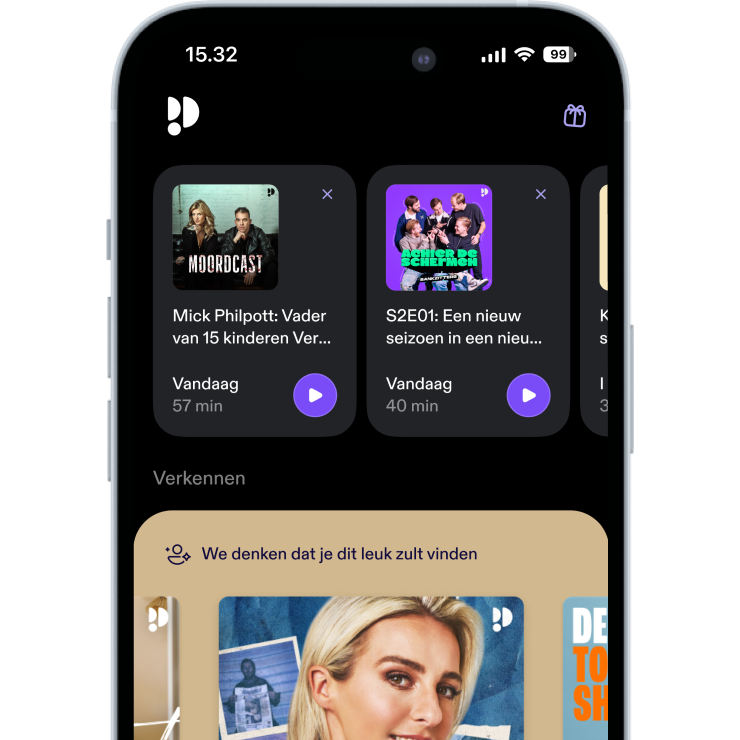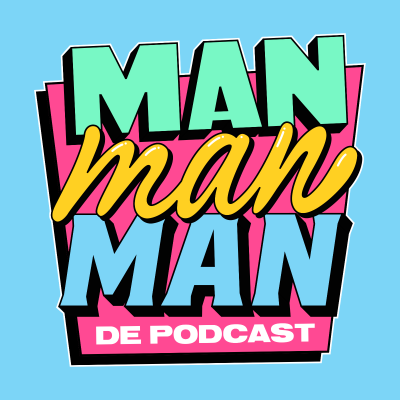
English language Visionary Marketing Podcasts
Podcast door Visionary Marketing
Tijdelijke aanbieding
3 maanden voor € 1,00
Daarna € 9,99 / maandElk moment opzegbaar.

Meer dan 1 miljoen luisteraars
Je zult van Podimo houden en je bent niet de enige
Rated 4.7 in the App Store
Over English language Visionary Marketing Podcasts
Visionary Marketing Podcasts in English
Alle afleveringen
88 afleveringenAI is radically transforming the B2B sales landscape and accelerating the shift towards intelligent sales enablement. At a major B2B event which took place in Paris in July 2025, I met with Stephane Renger, co-founder and managing director of Salesapps [https://salesapps.io]. The leading European sales enablement vendor has placed AI at the heart of its innovation strategy. In this interview conducted at the event, Stephane explains how AI agents are revolutionising commercial efficiency whilst maximising security and privacy. A fascinating dive into the future of AI-powered sales enablement that’s redefining commercial performance standards. AI SAVES TIME FOR SALES AND MARKETING TEAMS AI Sales Enablement [https://visionarymarketing.com/wp-content/uploads/2025/07/stephane-renger-btob-img-4244-scaled-e1751522660792.jpeg] AI-powered sales enablement : Stephane Renger is the co-founder and General Manager of European sales enablement company Salesapps. HOW IS AI TRANSFORMING SALES ENABLEMENT AND SALES IN GENERAL? Stephane Renger: At Salesapps, we’re working on AI agents with the goal of bringing greater efficiency to sales teams, while maximising data privacy and security. SPECIFICALLY, WHAT DO THESE AI AGENTS DO? S.R. We developed three types of intelligent agents for our AI-powered sales enablement solution. 1. The ‘company profiler‘ AI agent analyses the targeted business regarding its strengths, weaknesses, products, competition, news…, 2. The ‘individual profiler’ agent describes the buyer’s profile: background, interests, pain points… Then we use content enrichment agents with metadata to generate sales presentations and pitches, 3. Finally, our ‘conversational agent’ restructures meeting minutes and reports. AI Sales Enablement [https://visionarymarketing.com/wp-content/uploads/2025/07/btob-summit-parc-des-princes-1.jpg] Once again, this major B2B event took place in the prestigious premises of the Parc des Princes in Paris, with a focus on AI-powered sales enablement. WHAT ARE THE EFFICIENCY GAINS FROM THE IMPLEMENTATION OF AI WITHIN SALES ENABLEMENT? S.R. They are quite blatant, mainly in terms of time savings. Thanks to AI, salespeople quickly access information that used to take hours to research. > For a complete sales team, there is at least 20% time saving, which equates to one working day every week. Marketing teams and content managers can save up to 50% of their time. IS THIS AN OPPORTUNITY FOR GETTING RID OF SALESPEOPLE? S.R. No, it’s not. Salespeople only spend one third of their time actually selling. Two thirds are devoted to paperwork, CRM, preparation. Automation frees up their time from what isn’t their core business. ARE CERTAIN SALES ROLES MORE THREATENED THAN OTHERS? S.R. It depends mainly on the products being sold. The buyer only spends 5% of their time with the salesperson, 80% of the purchasing process happens on the web. So the remaining 5% must involve a complex buying process to require human intervention. In other cases, self-service is way sufficient, even in B2B. IN A NUTSHELL, SALES ENABLEMENT BECOMES AI-POWERED SALES? S. R. For the past two years, we’ve been talking more about ‘AI-powered sales enablement’ than traditional Sales Enablement. This concept is more immediately understandable and evokes innovation in the commercial approach. Worthy of note, for English-speaking markets, we keep that term ‘sales enablement’, but for French-speaking markets, ‘Modern Selling’ is the term of choice. It is more meaningful, especially when discussing AI agent integration, for French-speaking audiences who do not always understand the word ‘enablement’. WHAT CAN YOU TELL US ABOUT RELIABILITY AND SECURITY CONCERNS? S.R. Classic AI models, be it Gemini, ChatGPT, or others are used to research public information. If I want to know who you are or what your company does, there’s nothing better than such a tool that will browse the web, LinkedIn, and other sources to obtain this information. But if I want to process proprietary information, an internal document database, some meeting minutes, an internal conversation, etc., we must ensure data privacy and security at all cost. In this case, we’d rather work with on-premise language models that we can monitor end-to-end. We’ll feed them with this internal information and secure that information. WHAT ARE YOUR VIEWS REGARDING THE FUTURE OF AI-POWERED SALES ENABLEMENT? S.R. It’s very difficult to predict the future even three to six months from now. Our focus revolves around artificial intelligence. Its performance is increasingly impressive and prices more affordable. Right now, I’m particularly focused on sales coaching and training, and commercial skills development. Simulation and capturing a real-life interview in audio is already possible, but video is still relatively expensive, almost €50 per hour. With the lightning-fast progress in synthetic voices and images, I’m convinced that within three to six months, we’ll be able to offer much more advanced technologies at prices that will allow widespread distribution of this type of agent to sales populations and businesses. IN CONCLUSION: THE AI-POWERED SALES REVOLUTION These past ten years, Visionary Marketing has written quite a few pieces and white papers on the subject of Sales Enablement. Since then, technological progress and sales team transformation have been lightning fast. This interview with Stephane Renger perfectly illustrates this profound transformation of the sales domain. AI-powered sales enablement is now fully operational, and this technology is redefining commercial efficiency. The productivity gains quoted by Salesapps — 20% for sales teams, 50% for marketing teams — are a sign that something serious is happening now. What struck me at this major B2B event in Paris, was the profound transformation of the market offering in this domain. A few years ago, this side of the water, many Sales Enablement vendors were present, either international or local. In just a couple of years, Salesapps* established itself as the undisputed leader in this sales enablement market in French-speaking countries and is now conquering other markets. The future looks exciting: between conversational AI agents, personalised coaching, and predictive analysis, tomorrow’s salesperson will have tools at her disposal of unmatched power. We haven’t yet seen the end of the evolution of the sales function, and digital technologies are playing a major role in this upheaval. [*Disclosure: Visionary Marketing worked for Salesapps in 2022] The post AI Sales Enablement: 20% Time Savings for Sales and 50% for Marketing [https://visionarymarketing.com/en/2025/07/04/ai-sales-enablement/] appeared first on Marketing and Innovation [https://visionarymarketing.com/en/].
Are AI and developers the world’s best friends or is artificial intelligence a threat to the future of programmers? As artificial intelligence models are becoming increasingly sophisticated, many questions are raised about the future of developers across the industry. Will AI replace programmers entirely, as Eric Schmidt and Dario Amodei are predicting? Will junior developers be facing extinction, as Steve Yegge surmised in a now-famous blog post? Or are we witnessing the dawn of a new era in which technology amplifies human creativity rather than replacing it? I interviewed Nathaniel Okenwa, Developer Evangelist at Twilio [https://www.twilio.com/en-us], to pick his brains about this question, and his conclusion is that, in the future, software development will undoubtedly remain human-driven even though many changes [https://visionarymarketing.com/en/2025/04/24/change-management-lessons/] will occur. The video recording of that interview is available at the end of this blog post. DEVELOPERS AND AI: THE PATH TO THE FUTURE OF CODING [https://visionarymarketing.com/wp-content/uploads/2025/06/nathaniel-1024x576.jpg] With nearly a decade of hands-on programming experience and a unique perspective on developer community engagement, Nathaniel Okenwa brought both technical depth and strategic insight to this conversation about the evolving landscape of software development. SPREADING THE GOSPEL OF DEVELOPER TOOLS “My parents celebrated when I got that job title of developer evangelist,” Okenwa said. “I speak and meet with developers, online or in person, and I talk about the tools and the technologies they’re using. A part of this job is being with the community and then spreading the good news of Twilio as well.” [https://visionarymarketing.com/wp-content/uploads/2025/06/41928562521-5991ff5f14-k-1-1024x576.jpg]AI and programmers, a love-hate relationship? — image antimuseum.com [https://antimuseum.com] For those unfamiliar with the company, “Twilio is a customer engagement platform and one of the providers helping businesses with their customer support, communication tools, and APIs.” THE JUNIOR DEVELOPER DILEMMA The elephant in the room for the Tech industry is the fate of junior developers. Steve Yegge’s provocative piece ‘The Death of the Junior Developer [https://vismktg.info/death]’ has sparked intense debate, suggesting that AI won’t make inexperienced developers smarter but will enable experienced programmers to eliminate the need for juniors altogether. A daunting perspective for young programmers. Nathaniel offers a more nuanced perspective that challenges this binary thinking . > Often, a company doesn’t hire junior developers for their current capabilities. They recruit them because they’re investing in what they will become in the future. Junior developers need to exist if we are going to have mid-level senior developers, developer leaders, and architects at a later time. Nathaniel is right. Programming isn’t just about syntax and algorithms; it’s about developing problem-solving instincts, understanding business contexts, and learning to translate human needs into technological solutions. ‘If you want to create the next generation of builders, then I don’t think junior developers are going to disappear in the long term. We may forget how important they are for a little bit, but they will definitely make a comeback later on.’ THE ERIC SCHMIDT PROPHECY: SIX MONTHS TO OBSOLESCENCE? The urgency of these questions intensified when Eric Schmidt, former CEO of Alphabet, made bold predictions about the timeline for developer displacement. His assertion that developers would be reduced to merely correcting AI output within six months and potentially eliminated entirely within a year sent shivers down the spines of the programming community. Nathaniel acknowledges the partial truth in Schmidt’s predictions while advocating for a more sophisticated understanding of what developers do. “I think there are elements of truth in it, but I think the situation is a bit more nuanced. AI is, in my mind, another Industrial Revolution. In this context, it means we’ll be looking for repeatable tasks that are extremely simple and how to replace them with technology.” AI and developers [https://visionarymarketing.com/wp-content/uploads/2025/06/15235521427-8f5574e2dc-k-1024x576.jpg]AI and developers: programming isn’t just about writing code, it’s about solving business issues — image of a banker in a large banking institution antimuseum.com [https://antimuseum.com] The industrial revolution analogy is particularly apt here. Just as mechanisation didn’t eliminate human work but transformed it, AI appears poised to reshape rather than replace programming roles. “I think AI is going to take some aspects of programming and make them so cheap from an effort perspective that it’s not necessarily going to be the best use of people’s time. However, I think developers aren’t just folks that are repeatedly solving minor syntax sentences. They are creative builders coming up with different ways of taking a real-world problem and abstracting it into technology pieces.” AI AND DEVELOPERS: THE ABSTRACTION LADDER One of the most compelling aspects of Nathaniel’s perspective is his emphasis on abstraction as the key to understanding how AI will transform development work. Rather than replacing developers, AI represents another rung on the abstraction ladder that programmers have been climbing for decades. > Right now, I can use my programming skills to build a website and serve it to millions of people on the Internet. Thirty or forty years ago, I would have needed a whole set of different skills to make that happen. I would have needed so many more hardware skills and so many more specific high-level networking skills. And all of those things have been abstracted away for me to really focus on making this website really fast and performant. This historical perspective illuminates a pattern that AI-anxious people are missing. Each generation of developers has built upon increasingly sophisticated foundations, allowing them to tackle more complex problems without getting bogged down in lower-level implementation details. AI and developers [https://visionarymarketing.com/wp-content/uploads/2025/06/ygourven-split-screen-composition-showing-printing-press-worker-3eb9b335-2e3c-4b9b-a70c-72ba516fbac2-1024x574.jpg]AI, the printing press and developers. A brilliant analogy by Twilio’s Nathaniel Okenwa — image produced with Midjourney The printing press analogy further clarifies this progression: “If we think about the printing press, at first you needed to have lots of people who would sit down and handwrite a book in order for you to make 100 copies. The printing press came around, and the amount of effort and skills to achieve that shrunk considerably. But you still needed someone who could run that printing press.” THE INCONVENIENT TRUTH: NOT EVERYONE ASCENDS However, this progression toward higher abstraction levels raises uncomfortable questions about inclusivity and capability. Not every developer possesses the intellectual agility to continuously climb the abstraction ladder, and there’s value in acknowledging this reality. Nathaniel addresses this concern with characteristic optimism while maintaining realism. “I suppose there will always be people who remain comfortable doing what they are doing in the ways they are doing it. But with technology making so many more different things available, what’s going to happen is users, customers, and the general public are all going to expect more from our technologies and from us.” The market forces driving this evolution are relentless. As AI enables higher-quality experiences at scale, customer expectations rise accordingly, creating pressure on all technology providers to evolve or risk irrelevance. “The folks who aren’t meeting these higher standards of experiences will not be able to deliver the value that their customers and employers are expecting from them. If they don’t continue to meet that bar of expectation that is growing higher and higher, especially as AI helps people to develop new ways of doing this, they will be left behind.” THE DIGITAL TRANSFORMATION PARADOX This raises an interesting paradox about digital transformation that I’ve observed throughout my career in technology consulting. Thirty years ago, we predicted that traditional industries like banking would be disrupted by digital-native competitors. Yet established banks have largely survived, adapting gradually while maintaining their market positions. Nathaniel offers an insightful perspective on this seeming contradiction: “It didn’t kill banks, but I would argue that even if maybe they took a while to get there, the way we interact with our banks is completely different from the way we interacted with banks when we were younger. There are 18-year-olds who have no idea what a chequebook is.” The transformation happened, but more gradually and less dramatically than predicted. This pattern suggests that AI’s impact on development may follow a similar trajectory—profound but evolutionary rather than revolutionary. THE GITHUB CO-PILOT PARADIGM: INTEGRATION OVER REPLACEMENT Perhaps the most practical insight from our conversation concerns how AI tools are being adopted by developers. The success of GitHub Copilot and similar tools demonstrates that integration beats replacement as an adoption strategy. “Sometimes there are engineers who are reluctant to use AI or don’t want to go out of their way to bring AI into their workflows. But when Copilot came out, when other tools that have that technology built into the applications, the interfaces they are already using, the adoption increases significantly.” This observation reveals a crucial truth about technology adoption: the most successful innovations enhance existing workflows rather than demanding entirely new ones. The future of development tools lies not in replacing programmers but in making them more effective within familiar environments. THE COPY-PASTE CONTINUUM One of the most honest moments in our conversation addressed the reality of code reuse – something every developer practises but few discuss openly. The fear that AI will turn programmers into mindless copy-paste operators misses the historical context of how developers have always worked. “Copying and pasting has been an integral part of the engineer’s journey for decades, and it’s not going anywhere soon. Even if we are copying and pasting from a different place, and even if we are no longer using Ctrl-C and Ctrl-V, we have always been learning from the code that others write.” The key distinction lies not in the source of solutions but in the developer’s understanding of what they’re implementing. “The real issue is that of developers who go and find a solution online and copy and paste it without understanding what is going on. Now, if people do that with AI, they may create a black box, and that’s going to be great when it works. But when it doesn’t, when you receive a phone call in the middle of the night, and that production’s gone down, that’s a different kettle of fish. Having a black box is not going to be something that a huge company, a huge enterprise, is going to want to rely on.” THE COBOL CONUNDRUM: LEGACY SYSTEMS AND HUMAN RESISTANCE Our conversation touched on one of the most persistent challenges in enterprise software: the prevalence of legacy systems built in languages like COBOL that have resisted modernisation for decades. This serves as a fascinating case study in the relationship between technological possibility and human decision-making. > I think we underestimate the power of people. People are sometimes afraid of change. They sometimes want to rely on what has worked for years. And so, even if AI presents a great solution, it’s going to be people who decide whether to take it on board or not. This observation cuts to the heart of why technological predictions often prove overly optimistic. Technical feasibility doesn’t guarantee adoption, and institutional inertia remains a powerful force in shaping the pace of change. ADVICE FOR THE NEXT GENERATION OF DEVELOPERS For students and emerging developers wondering how to navigate this uncertain landscape, Nathaniel offers pragmatic guidance that emphasises exploration. “The first thing is to explore and experiment. Experiment with the new technologies. Find out what those new job titles are going to be and chart the path to become an expert. Either a specialist in using AI as a tool, or an expert in creating AI, or an expert in maximising its performance, or an expert in building the tools that AI will use.” Nathaniel’s emphasis on APIs is particularly noteworthy: “APIs are nothing new. The better your API, the better the AI agents that will resort to it.” This suggests that developers who understand how to build AI-friendly interfaces will find themselves increasingly valuable. Most importantly, he advocates for focusing on uniquely human contributions: “Don’t just focus on the typical tasks a junior developer is asked to do because AI can do them really well. Instead, focus on the ways that you can bring a unique twist to your solution.” AI AND DEVELOPERS: EMBRACING CHANGE WHILE STAYING HUMAN As our conversation with Nathaniel Okenwa demonstrates, the future of developers isn’t about choosing between human programmers and AI systems—it’s about understanding how these technologies can work together to solve increasingly complex problems. The most successful developers will be those who embrace AI as a powerful tool while focusing on the uniquely human aspects of software development: creativity, problem-solving, and the ability to translate human needs into technological solutions. In a sense Nathaniel’s advice isn’t that different from Steve Yegge’s. You’ll have to become an expert to make good use of AI; it’s not artificial intelligence that will turn you into an expert. Rather than fearing obsolescence, developers should view this moment as an opportunity to evolve, much as previous generations adapted to new programming languages, frameworks, and paradigms. The future belongs to those who can harness AI’s capabilities while providing the human insight, creativity, and understanding that no algorithm can replicate. The future of developers isn’t about replacement—it’s about enhancement, evolution, and the continued pursuit of building technology that serves human needs. In that mission, developers remain not just relevant but essential. The post The Future of Developers in the Age of AI [https://visionarymarketing.com/en/2025/06/25/ai-and-developers/] appeared first on Marketing and Innovation [https://visionarymarketing.com/en/].
How do luxury brands maximize experiences in sports events? I attended the 2025 Monte-Carlo Masters, which showed a strong presence of elite brands fighting for high-end customer engagement. Brands such as Rolex, Sergio Tacchini, and Replay can be found advertised almost everywhere at the famous tennis tournament. These brands use the values of this tennis tournament’s identity, which are class, prestige, excellence, and exclusivity, to reinforce their brand image [https://visionarymarketing.com/en/2024/09/27/brand-talk/]. In this article we will be looking into the strategy behind premium companies and their connection to the Monte-Carlo Masters Tennis Tournament. LUXURY BRANDS MAXIMIZE EXPERIENCES IN SPORTS EVENTS luxury-brands-in-sports-events [https://visionarymarketing.com/wp-content/uploads/2025/04/tennis3.jpg]This photo was made using Midjourney and Adobe Photoshop. SPORTS SPONSORSHIP IN LUXURY BRANDING Luxury brands have had a history of gravitating towards sports such as tennis, golf and equestrian sports because these sports emphasized precision, elegance, and tradition. [https://www.linkedin.com/pulse/luxury-sponsorships-sports-how-prestige-brands-investing-yovhf/] Brands saw that it seemed like a good fit for their deluxe identity due to the traditional affluent audiences that these sports offered. Only the best of the best athletes competing at these events align with the values of the most luxurious brands that they are the best of what they do. These brands are able to prolong their exclusivity while opening up visibility to sports viewership. As brands become bigger and sports viewership grows, stylish brands are opening up to collaborations with bigger sports that may not have as much class or prestige, such as football and basketball. STRATEGIC BRAND POSITIONING AT THE MONTE-CARLO MASTERS What once was known as the Monte-Carlo Masters is now known as the Rolex Monte-Carlo Masters. Rolex has positioned themselves front and center at a prestige tournament. Not only are they in the title of the tournament, they are on the logo and can be found everywhere at the tournament itself. Another brand that has strategically positioned itself is Sergio Tacchini. Being at the tournament itself, it is impossible to miss; every ball kid and many employees working for the tournament wear a piece of clothing from Sergio Tacchini. Just being at the tournament, you are constantly being advertised to, whether you realize it or not; everywhere you look, you are reading another brand name. Other brands, such as Maserati and Emirates, help back the elitist and prestigious image of the tournament. Monaco, home of the tournament, is known for its wealth as well as its opulent residents, one more reason to advertise an elegant brand, as the target market is mainly wealthy individuals. “According to the World Population Review, Monaco is the richest country in the world [https://www.bnbrickeys.com/es/blog/why-do-rich-people-choose-to-live-in-monaco] in terms of GDP per capita and is regarded as the “billionaires’ playground.” Celebrities and top-level athletes being at the tournament make being at the event feel like it’s only for those of wealth, class, and elegance. luxury-brands-in-sports-events [https://visionarymarketing.com/wp-content/uploads/2025/04/porsche.jpeg]This photo was made using Midjourney and Adobe Photoshop. BRAND AND CUSTOMER EXPERIENCES Some of the most exclusive experiences at the Monte-Carlo Masters are sponsored by posh brands. VIP lounges and luxury suites are curated for high-end customers and guests. Additionally, behind-the-scenes access, meet-and-greets with athletes, and fancy gifting moments allow brands to showcase their exclusivity even more to only those that can afford them. Hospitality packages [https://montecarlotennismasters.com/en/hospitality/hospitality-packages/] include gifts, discounts, special access, and events made to feel extraordinarily classy. The Société des Bains de Mer (SBM), which is responsible for venues at the event, creates gourmet dining opportunities as well as private lounges mimicking luxury brands. Customers at the Monte-Carlo Masters are rewarded just by being at the event itself. These rewards include access to limited edition merchandise, entries to giveaways or raffles, and the opportunity to use the VR Tennis simulator. To further show status of class and order, boutiques at the event are limited to a certain amount of people at a time to prevent cluttering. When a customer buys a ticket for the tennis match, they are not just coming to watch one game, they are spending practically the whole day there. Even in between matches there are activities to be done around the venue. These activities include, finding something to eat (there are a lot of choices), VR tennis simulator, walking around and exploring the area, shopping in the countless boutiques and tennis stores. SCARCITY AND “LIMITED EDITION” The value of going to a sports event comes from the electric anticipation of not knowing what will happen. Fans come to witness firsthand the action and to purchase limited edition [https://www.linkedin.com/pulse/what-luxury-marketing-can-learn-from-sports-winning-playbook-toueg-7b9we/] products showing they were there. Rolex and other brands offer merchandise exclusive to the event itself, signifying someone was at the event. A piece of limited edition merchandise to show you were at the Rolex Monte-Carlo Masters is also an advertisement every time you wear it in public. Short-term promotions and exclusive collaborations build a sense of urgency [https://www.linkedin.com/pulse/what-luxury-marketing-can-learn-from-sports-winning-playbook-toueg-7b9we/] used to encourage customers to buy their product. Brands use this to drive up their exclusivity, giving only people that were at the event a chance to purchase something that will remind them of how special that moment was. [https://visionarymarketing.com/wp-content/uploads/2025/04/whatsapp-image-2025-04-18-at-133943-325d7e18.jpg]This photo was made using Midjourney. CONTENT AND SOCIAL/DIGITAL MEDIA Social media has completely changed this world as we know it, and that is not only limited to the social aspect, but it has changed the business world drastically. Content creation is a great way to gain publicity, and what better place than a sports event to promote your upscale brand? Brands such as Replay [https://www.instagram.com/reel/DIWCoQJolQ4/?igsh=MTFvODdmaHU4aWQ1aw==] and Malongo [https://www.instagram.com/reel/DIN3ofpNIl4/?igsh=bWNqNW1xN21mbW1i] took advantage of this event sponsorship and made social media promotions showing their collaboration with the renowned event. ROLEX AND TENNIS Rolex has been partnering with tennis for 46 years, since 1978. luxury-brands-in-sports-events [https://visionarymarketing.com/wp-content/uploads/2025/04/untitled-13.jpeg]Made with Napkin AI. KEY STATISTICS ABOUT LUXURY BRANDS IN SPORTS EVENTS These statistics show that the tournament continues to improve their technology and assets. Furthermore increasing their brand identity relating to top class. luxury-brands-in-sports-events [https://visionarymarketing.com/wp-content/uploads/2025/04/s.jpg]Maximizing luxury brands customer engagement in sports events: facts and figures about the 2025 Monte-Carlo Masters – infographic done with Canva CONCLUSION Classy, lavish brands strive to take advantage of events such as the Monte-Carlo Masters tournament to build brand identity and to increase publicity. The Monte-Carlo Masters serves as a sort of “playground” for luxurious brands to strategize, promote, and attach themselves to the values that the event portrays. Brands that strive to align with excellence, class, prestige, and elitism promote themselves using the Monte-Carlo Masters to represent these traits. These companies take advantage of the tournament knowing that the audience is generally wealthier. The post Luxury Brands Maximize Experiences in Sports Events [https://visionarymarketing.com/en/2025/04/22/luxury-brands-in-sports-events/] appeared first on Marketing and Innovation [https://visionarymarketing.com/en/].
If you are dying to understand the various GenAI prompting methods, how AI interacts with your prompt, and why this is key to optimising your results, this free prompting guide was made for you. This manual describes GenAI chatbots and the different methods of prompting. It was put forward by Frederic Cavazza [https://fredcavazza.net/contact/], a digital transformation expert, consultant and speaker with over 25 years of experience. A FREE PROMPTING GUIDE FOR ASPIRING GENAI EXPERTS GenAI prompting guide [https://visionarymarketing.com/wp-content/uploads/2025/04/abc-of-prompting-cover-picture.jpg]This free GenAI prompting guide written by Frederic Cavazza was translated and adapted by yours truly. I’ve known Frederic Cavazza for years and I’ve even had the pleasure of working on a few engagements with him. As we were on our way to a GenAI client workshop a few months ago, he showed me this guide and I thought to myself: “This is exactly what I’d like to share with my readers and students”. Hence this translation and adaption of Frederic’s prompting guide, with his kind permission. I tried his tricks myself and I can guarantee that the mega prompt he describes at the end of the guide is really something you should test, copy, paste, adapt and keep in your own prompt library. A GENAI GUIDE ABOUT THE ART OF PROMPTING Artificial intelligence is booming, and chatbots like ChatGPT are radically transforming the way we interact with digital tools, changing the way we work. This guide aims to introduce you to the art of ‘prompting’, a key skill for engaging effectively with these artificial intelligence platforms and making the most of their potential. If you’re researching a topic on the Web and you type in a simple key phrase, the result may not be very compelling. On the other hand, if you structure your search well, you’ll get more relevant answers. And so it goes with artificial intelligence tools like chatbots or digital assistants. Frédéric Cavazza, the ABC of Prompting. [https://visionarymarketing.com/wp-content/uploads/2025/04/frederic-cavazza-prompting-guide.jpg]Frederic Cavazza is the author of this great prompting guide entitled the ABC of prompting – photo portrait by antimuseum.com [https://antimuseum.com] > The more structured the prompt, the more relevant the outcome GENAI PROMPTING? The way you ask AI chatbots questions or give them instructions is conducive to more or less convincing results. This is what is called ‘prompting’, i.e., the art of formulating clear and precise instructions to guide the work of artificial intelligence models. In essence, a well-structured prompt is like a well-formulated search query. When done properly, it shall provide relevant results. There is no one-size-fits-all prompt methodology, as use cases differ from one user to another. However, we recommend you use one of these three methods based on your needs. THREE RECOMMENDED GENAI PROMPTING METHODS These three methods are entitled RTF (Role, task, format), CRAFT (Context, role, action, format, tone of voice) and COAT-SITES (context objective, acumen, task, specimen, impediments, tone of voice, encoding, scrutiny). Each technique works best depending on expected results. RTF was made for quick results, CRAFT, for simple questions with more accurate results and COAT-SITES, for clear cut questions and extensive results. So, what are these methods about? Here they are in more detail. 1. RTF METHOD With RTF, the prompts specify the role, task and format that AI should adhere to. It consists in a simple, “you are…, you must…, your answer must…” Role indicates who the AI bot should impersonate, providing a contextual framework. Task, gives AI the precise action or problem to be solved, guiding AI towards the expected objective. And Format specifies the type and structure of the outcome. 2. CRAFT METHOD Should you be looking for more accurate results, it might then be a good idea to expand your prompt to incorporate more context. The CRAFT method is therefore what you would have to resort to. CRAFT implies providing specifics to the AI chatbot in your prompt such as, “I’m in charge of…, you are… you have to…, your answer should include…, choose the following tone of voice.” With the CRAFT method, Context describes the overall situation or requirement. Role, tells AI the character it should enact. Action, specifies what AI must do, directing the LLM. Format, provides examples or details clarifying final expectations. Tone of voice, defines the expected style or category AI must follow, aligning your response with your objective and audience. Expanding your prompt to formulate a better structured and accurate result. 3. COAT-SITES METHOD In the case of COAT-SITES technique, your prompt is not only expanding the context of the situation but giving AI strict guidelines to narrow the margin of misunderstanding. Allowing for your results to be more accurate and extensive. This includes Context, Task, Tone of voice, as in the previous methods but also includes Objective, Acumen, Specimen, Impediments, Encoding and Scrutiny. Objective and Acumen, give AI the tools to reach your expected result with the correct level of expertise. Specimen and Impediments, provide clear examples and guidelines of what is wanted and what should be avoided. By providing models or illustrations, you clarify the expectations, just like defining what cannot be done narrows down your result. Lastly, COAT-SITES encompasses Encoding and Scrutiny. Encoding defines the output format syncing the results to your objective and scrutiny offers a final sanity check to ensure the results comply with your stated guidelines. TEST DRIVE THE PROMPTING METHODS Once you have familiarized yourself with these three prompting methodologies, give them a go. Here are some tips and tricks to keep in mind when navigating GenAI chatbots. Frederic details them all in the guide for you. After you have signed in to a chatbot, enter a few questions into the prompt window to get a feel for how it replies. After you’ve done that, try testing out the suggested prompting methods, saving a specific topic or tricky task for COAT-SITES. TIPS AND TRICKS When interacting with your favourite chatbot, remember to select relevant keywords, stick to one question at a time, test and tweak your prompts and follow up. Don’t settle for half-baked answers and consider asking a different chatbot to critique your results. Lastly, remember at all times that the better formulated your prompt, the better AI can provide accurate and relevant results. So give these methods a test and see how your interaction with GenAI chatbots evolves. Download now our GenAI Prompting guide [https://visionarymarketing.com/wp-content/uploads/2025/04/donwload-now-button.png]https://visionarymarketing.com/wp-content/uploads/2025/04/abc-prompting-english-v2-3.pdf DOWNLOAD FOR FREE THE ABC OF PROMPTING FOR ASPIRING GENAI EXPERTS BY FRÉDÉRIC CAVAZZA The post GenAI Prompting Guide for Aspiring Experts [https://visionarymarketing.com/en/2025/04/16/genai-prompting-guide-for-aspiring-experts/] appeared first on Marketing and Innovation [https://visionarymarketing.com/en/].
How is AI Search changing the Internet and what role are we playing in this transformation? In this article, I discuss the current state of adoption of AI-powered search engines [https://visionarymarketing.com/en/2020/11/16/have-search-engines-become-useless/]. By reflecting on the perspectives of Kevin Roose, Matteo Wong and Joanna Stern, this piece explores what we gain—faster, more organized access to information—and what we risk losing—the diversity of sources, depth of content and our curiosity to go beyond a single answer. BREAKING UP WITH YOUR TRADITIONAL SEARCH ENGINE How is AI Search changing the Internet and what role are we playing in it? [https://visionarymarketing.com/wp-content/uploads/2025/04/chatgpt-image-apr-8-2025-at-01-55-32-pm.jpg]How is AI Search changing the Internet and what role are we playing in it? — image generated with Canva and ChatGPT Is it time to ditch Google and your other favorite search engines? In the past few years, AI has disrupted numerous industries in the digital sector, but arguably one of the most noteworthy shifts has been in the online search market. Think of the last time you searched the internet for information—did you sift through pages of websites, or did AI place the answer at your feet? The decades-long reign of Google might just be challenged by this new age of conversational and contextually aware search power. THREE VOICES ON AI SEARCH: ROOSE, WONG AND STERN To examine this idea more deeply, this piece will consider three different articles written by Kevin Roose, Matteo Wong and Joanna Stern. As the conversation surrounding AI evolves, their observations offer unique points, from skepticism to adoption, reflecting the considerable development of AI capabilities and increasing adoption by users. By breaking down their findings and looking at the numbers of adoption, I will explore the current and future landscape of AI-powered search. So whether you’ve already hitched your ride to the AI bandwagon or are still clinging to your Google tabs, here’s a glance at where our process of search, the internet, and information is headed. AI Search [https://visionarymarketing.com/wp-content/uploads/2025/04/53603193082-4220c32d8a-k-e1744106543546.jpg]AI-Search at the speed of light — Photography by antimuseum.com [https://antimuseum.com] KEVIN ROOSE: CONTINUING WITH CAUTION [https://visionarymarketing.com/wp-content/uploads/2025/04/perplexity-logo-500x281.jpg]In February 2024, Kevin Roose wrote an article for The New York Times titled “Can This A.I.-Powered Search Engine Replace Google? It Has for Me.” [https://www.nytimes.com/2024/02/01/technology/perplexity-search-ai-google.html] As you might have guessed from the title, Roose’s experience was a positive one, but not without some hesitation. To test his theory, Roose gave up Google, instead opting for Perplexity, an AI search engine founded by former OpenAI and Meta researchers. Roose’s several-week adoption of Perplexity left him sufficiently convinced AI search engines were a valid competitor against traditional web browsers, but adjustments were needed if they are going to win the race. The information retrieval and contextual understanding offered by AI proved more useful for the majority of his work. However, due to AI’s limitations, Google was not obsolete. Acknowledging the absence of credible sources, real-time updates, and the occasional lack of truth AI provided, Roose found his usage of AI had certainly become more prominent, but most successful when used alongside Google. The article suggests the adoption of AI will not be a bold movement, but a gradual and natural shift in user behavior. Still indecisive on the effects AI will have on journalists, publishers and others who create the internet landscape, Roose stated, “I’ll have to weigh the convenience of using Perplexity against the worry that, by using it, I’m contributing to my own doom.” MATTEO WONG: EXPLORATORY SEARCH Roose is far from the only one to have concerns about the growing popularity of AI. The Atlantic’s Matteo Wong placed a heavy critique on AI in his article “The Death of Search.” [https://www.theatlantic.com/technology/archive/2024/11/ai-search-engines-curiosity/680594/] Wong’s piece focused less on the way in which a person uses AI and more on the way that AI changes our relationship with information. AI Search [https://visionarymarketing.com/wp-content/uploads/2025/04/chatgpt-image-apr-8-2025-at-02-16-55-pm.jpg]Should you cross traditional Internet Search off the list? Stern’s answer is a resounding YES ! – image generated with ChatGPT In his view, the concern is not AI’s credibility or factuality—those issues could be fixed as systems evolve—but the loss of an exploratory model of search. When people stop engaging critically with information, they lose the ability to evaluate and explore their own curiosity. He states, “It could completely reorient our relationship to knowledge, prioritizing rapid, detailed, abridged answers over a deep understanding and the consideration of varied sources and viewpoints.” The indication of Wong’s argument is that by extinguishing that exploratory model of search and making information “too” accessible, it dismantles the fundamental idea of the web. JOANNA STERN: EMBRACING CONVENIENCE In opposition to Wong’s take on the adoption of AI-powered search engines is Joanna Stern, who shared her full support in her New York Times article, “I Quit Google for ChatGPT—and I’m Not Going Back.” [https://www.wsj.com/tech/personal-tech/google-search-chatgpt-perplexity-gemini-6ac749d9] Stern’s piece rings similarly to Roose’s in that once she made the switch, the probability of going back was unlikely. [https://visionarymarketing.com/wp-content/uploads/2025/04/image-27-1024x569-1-500x278.png] Trying a variety of AI platforms, Stern found the ease and refinement of AI a refreshing break from sponsored links and promoted products offered by Google. Only in searching for a known product, website or article did Google still prove useful. While she noted AI is consistent with the limitations of poor sourcing and inaccurate information, Stern’s main concern was the loss of visibility and traffic for the information’s original source. What’s to keep AI from making these websites and publications obsolete, and who do you credit for the information you got? Stern wraps her argument into a neat bow by saying, “So, yes, I’ll encourage you to try AI for search, as long as you promise to click a link when you can.” MY EXPERIENCE WITH AI SEARCH While I have familiarized myself with the platforms ChatGPT and Perplexity, my experience with AI-powered search engines is still limited. However, from what I have seen, I am impressed. The concise, summarized answers leave me satisfied and often without lingering questions. Still, despite the efficiency, I have found I do not stray far from Google. I am not sure if it is a habit or precaution. LOOKING TO THE FUTURE So where do you stand? Are you ready to commit to AI, or is apprehension holding you back? As each article shows us, the level of adoption is varying, and chances are you’re somewhere in the middle. But there’s no doubt the way we access and receive information is changing. The worldwide market size of AI [https://www.statista.com/forecasts/1474143/global-ai-market-size] jumped from approximately $50 billion to $184 billion in just one year. [https://visionarymarketing.com/wp-content/uploads/2025/04/statistic-id1454204-us-adults-using-generative-ai-usage-first-for-online-search-2023-2027.png] Additionally, a survey by Activate [https://www.statista.com/statistics/1454204/united-states-generative-ai-primary-usage-online-search/] tells us the number of adults in the United States using AI first for their online search was around 13 million just two years ago and is projected to reach 90 million by 2027. The growth is telling, and it’s not limited to one platform. ChatGPT, Perplexity, Copilot, Claude—even Google is trying to reinvent itself with Gemini. So whether you’re a curious newcomer, cautious observer or full-on convert, it’s clear we are stepping into a new age of internet. Moving forward we will have to decide if the gains outweigh the losses and with continual adoption, new questions arise. Will AI search enhance or limit access to diverse perspectives? How much of a role will it play in our daily lives? I guess we will have to wait and see. AI Search [https://visionarymarketing.com/wp-content/uploads/2025/04/53603192717-c8bdbe1ff5-k-e1744106517733.jpg]AI search is taking Internet search a level higher — photo by antimuseum.com The post AI Search : Breaking Up With Your Traditional Search Engine [https://visionarymarketing.com/en/2025/04/08/ai-search/] appeared first on Marketing and Innovation [https://visionarymarketing.com/en/].

Rated 4.7 in the App Store
Tijdelijke aanbieding
3 maanden voor € 1,00
Daarna € 9,99 / maandElk moment opzegbaar.
Exclusieve podcasts
Advertentievrij
Gratis podcasts
Luisterboeken
20 uur / maand

































